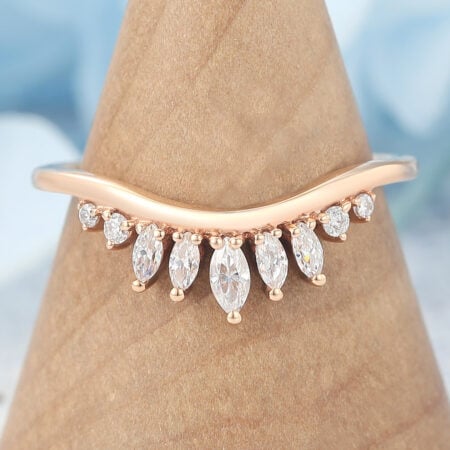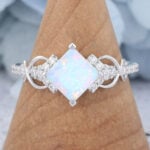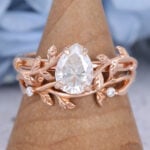Gold Hardness Explained: Is Gold Durable Enough for Everyday Wear?
Gold is one of the most popular metals in jewelry, but not all gold is equally durable. The concept of gold hardness plays a key role in how well your jewelry holds up to daily wear. From soft 24K gold to stronger 14K options, understanding how gold’s hardness affects its resistance to scratches, bending, and long-term wear is essential when choosing the right piece for everyday use.
The History of Gold
As early as 4000 BC, gold was used by Mesopotamians and Egyptians as gold ornaments and decorations for pharaohs’ masks, coffins and temples, symbolizing holiness and power.
In ancient Greece and Rome, gold became a symbol of royalty and authority, and was also used to mint currency, reflecting identity and economy.
In the Middle Ages, gold played an important role in religious culture, symbolizing sacredness and inviolability.
In modern times, gold has become the core of the international monetary system. Until now, gold is still widely used around the world as a safe-haven asset, jewelry material and means of storing value.
What Is the Hardness of Gold?
Like gemstones, gold’s hardness is measured using the Mohs Hardness Scale, which is based on the ability of a material to resist being scratched. The higher the number, the harder the substance. While diamonds have a Mohs hardness of 10, pure gold (24K) ranks only 2.5 to 3, making it a much softer metal that scratches and deforms easily.
Other Gold Purity Levels and Their Hardness
10k gold
10K gold is the lowest purity grade allowed by US law to be labeled as “gold”, with a gold content of about 41.7%, and the remaining 58.3% being metal alloys such as copper, silver, zinc or nickel. Due to the high alloy ratio, the hardness of 10K gold is significantly improved, with a Mohs hardness of about 4.5-5, making it the hardest of the three common K golds, and very suitable for making rings, bracelets and other accessories that are easily rubbed and scratched during daily wear.
14k gold
14K gold contains 58.5% pure gold and is one of the most common types of gold used in jewelry. Its color is medium golden yellow, which retains the luster of gold without being too strong. With a Mohs hardness of about 4–4.5, 14K gold is stronger than 18K gold, scratch-resistant and abrasion-resistant, making it very suitable for daily wear. It strikes a good balance between appearance and durability, making it a mainstream choice for engagement rings, wedding rings and everyday jewelry.
18k gold
18K gold contains 75% pure gold, making it one of the highest-purity metals used in fine jewelry. In terms of gold hardness, it measures about 3–4 on the Mohs scale. This relatively low 18K gold hardness means the metal is softer than 14K gold, making it more susceptible to scratches and minor deformation. However, its rich, deep color and luxurious appearance make it a popular choice for heirloom pieces, meaningful gifts, and special-occasion jewelry.
The Physical Properties of Gold (Au)
Color and Luster
Gold, with the chemical symbol Au, has a unique golden metallic luster and is one of the very few metals that are naturally yellow. Its surface is highly reflective and can show an extremely dazzling metallic luster after polishing, which is one of the important reasons why gold is so popular in jewelry and decorations.
Density
Gold has a density of 19.32 g/cm³, which makes it a very dense metal. This means that even if the volume is small, the mass of gold is very large.
Hardness
Pure gold has a Mohs rating of 2.5 to 3, placing it among the softest metals. While it offers excellent ductility and malleability, its low gold hardness makes it prone to scratches and deformation. For this reason, gold is often alloyed with other metals in jewelry making to improve its overall strength and wear resistance.
Ductility and Malleability
Gold is the most ductile and malleable of all metals. One gram of gold can be drawn into a filament several kilometers long, or hammered into gold foil only a few dozen nanometers thick. This extremely high ductility makes gold widely used in the electronics industry and decorative crafts.
Melting and Boiling Point
Gold has a melting point of 1064°C and a boiling point of about 2970°C. This melting point is relatively high for metals, making gold suitable for use as a conductive material or industrial coating in high-temperature environments.
Electrical and Thermal Conductivity
Gold has very good electrical and thermal conductivity, second only to silver and copper, so it is often used in high-end electronic components, connectors and precision circuits.
Also Read: Is 14K Gold Jewelry Worth Buying?
A Total Guide To Choosing Your Karat For Your Jewelry About 10K 14K Gold And 18K Gold
Types of Gold Alloys
Yellow Gold: Made from gold mixed with a small amount of silver and copper, retains the traditional gold look. Depending on the karat number, the color and hardness will vary.
White Gold: Made from gold and nickel, zinc or palladium, the surface is often plated with rhodium to increase the shine. The color is modern and is a common choice for engagement rings.
Rose Gold: Made from gold with a higher proportion of copper, it has a warm pink color. The style is romantic and has become very popular in recent years.
Green Gold: Made from gold and silver or cadmium, it has a light green or yellow-green luster. It is relatively rare and is often used in unique design jewelry.
Blue Gold: Made from gold and iron or aluminum alloy, it is oxidized to have a blue appearance. The color is unique, but it is not suitable for daily wear.
Purple Gold: Made from gold and aluminum to form an intermetallic compound, the surface has a natural purple color. The material is brittle and is often used for inlay decoration.

Comparison of Gold Hardness vs. Other Jewelry Metals
Gold vs Platinum
Platinum is denser and more durable, while gold hardness varies by purity and is generally lower. Compared to platinum, gold hardness makes it more prone to scratches and dents in daily wear.
Gold vs Silver
According to the Mohs hardness scale for metals, silver and pure gold both rank low in hardness. However, alloyed forms like 10k, 14k and 18k gold improve gold hardness, making it more resistant to wear than silver’s softer structure.
Gold vs Titanium
Titanium is significantly harder than gold and highly scratch-resistant. Even at lower karats, gold hardness is much lower, making gold less suitable for high-impact or rugged use.
Gold vs Copper:
Copper is slightly harder than pure gold, with a copper hardness Mohs scale rating of around 3. When alloyed, gold hardness increases enough to surpass that of copper in terms of durability and wear resistance.
Also Read:Platinum Vs White Gold Vs Sterling Silver Which Is Best For Your Jewelry
10K Gold vs 14K Gold vs 18K Gold, Which Type of Gold Is Best for Everyday Wear?
For everyday wear, 14K gold is often the best choice because it balances purity and durability effectively. Its moderate gold hardness makes it more resistant to scratches and deformation compared to higher karat golds. While it contains less pure gold than 18K, it still maintains a rich color and lasting shine, making it ideal for daily jewelry that can withstand regular use.
Common Gold Jewelry Wear Issues and How to Prevent Them
Common gold jewelry wear issues include scratches, bending, discoloration, and loose stones. Softer gold, like 18K, scratches more easily, while lower-karat alloys may cause discoloration. To prevent damage, choose gold with higher gold hardness such as 14K or 10K, avoid wearing jewelry during heavy activities, and store pieces separately. Regular professional checks and proper cleaning also help maintain durability and stone security.
Does Gold Hardness Affect Stone Security?
Gold hardness does affect stone security in jewelry. Softer gold, like 18K, is more prone to bending or scratching, which can loosen gemstone settings over time. Harder gold alloys, such as 14K or 10K with higher gold hardness, provide a more stable and durable setting, helping keep stones securely in place during everyday wear.
Conclusion
Gold hardness plays a crucial role in how well your jewelry holds up to daily use. Choosing the right karat—such as 14K for its strength and lasting shine—ensures your gold pieces stay beautiful and durable with regular wear.
FAQs About Gold Hardness
What is gold's hardness? How hard is gold?
Gold is a relatively soft metal, with a Mohs hardness of 2.5 to 3 in its pure form. It’s not very strong, which is why it’s often alloyed with other metals to improve durability.
Is gold a hard or soft metal? How soft is gold? Is pure gold brittle?
Gold is a soft and malleable metal, especially in its pure 24K form. This gold softness makes it easy to bend rather than brittle, but unsuitable for daily wear without alloying.
Is silver softer than gold? Is gold magnetic?
Sterling silver and pure gold have similar softness, but alloyed gold like 14K is usually harder. Gold is not magnetic, so it won’t be attracted to a magnet.
What is the texture of gold? Is gold a solid? Is pure gold weak?
Gold is a solid metal with a smooth, dense texture. Pure gold is soft and malleable, which makes it weak for daily wear due to low gold hardness.
Does gold tarnish or rust?
Gold does not rust or tarnish because it’s a chemically stable metal. However, lower-karat gold may dull over time due to alloy metals reacting with moisture or chemicals.
How much is 14k gold worth? Is 14k gold good? Will 14k gold tarnish?
14K gold is valuable and widely used in jewelry for its balance of durability and purity. It may slightly tarnish over time depending on the metals it’s alloyed with but is generally a good choice for everyday wear.
How hard is platinum? Is platinum better than gold?
Platinum is harder and more durable than most gold alloys. It resists wear well, but gold hardness in 14K gold can also offer strong performance depending on usage needs.
How to clean gold jewelry?
Use warm water, mild soap, and a soft brush to gently clean gold jewelry. Avoid harsh chemicals, and dry thoroughly to maintain shine and prevent damage.
 Christmas: 25% off All ltems · Code AFJ25 ·Ends Dec 30 30% off All Items ·On Orders Over $600 – Code AMANDA30
Christmas: 25% off All ltems · Code AFJ25 ·Ends Dec 30 30% off All Items ·On Orders Over $600 – Code AMANDA30


